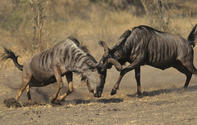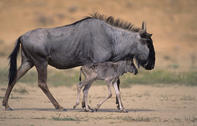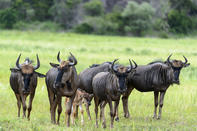Breed on the Run
Blue wildebeest are traditionally a migratory species. When resources are depleted, individual herds form massive aggregations (especially in places like Kenya) and they ‘breed on the run’ so to speak.

Where adequate food and water is available blue wildebeest are more sedentary and exhibit a harem system where the male selects and protects a demarcated territory containing the resources that female’s desire.
When the females roam into his area in search of fresh grass or water, the male will herd them and attempt to keep them in his territory (especially during the rut when they are in oestrus).
Females live in the herds in which they were born and young male’s band together in bachelor groups from the age of two years as this provides them with safety in numbers until they can contest a territory themselves.
In the meantime, bachelor groups are forced to use the fringes of territorial bulls’ habitats. Breeding herds move in homeranges that expand in drought conditions (up to three times) and become fairly stable during favourable times.
Designed for Travel

Blue wildebeest have bodies that are modified to accommodate their migratory habits. The slanted back is a result of shoulders that are positioned high on the body and long front legs. This structure allows wildebeest to canter for long distances.
The canter is an energy-efficient mode of locomotion that allows wildebeest to follow the signs of distant storms (thunder and lightning) at a pace faster than a walk but less tiring than a full out run or trot. Telling male and female blue wildebeest apart can be tricky as both sexes have horns.
The females are slightly browner in colour with a little russet on the forehead but juveniles also have brown on the faces so this could be confusing. If seen from the side, the male’s penis sheath breaks the curve of his belly. Most reliably the horns of the two sexes differ slightly with the male’s horns (which are slightly heavier) extending further than the end of the ear before curving upwards.
Lone Males

A typical blue wildebeest territory is usually positioned in the direct vicinity of water and somewhere nearby a sandy area that can be used as a stomping ground. Wildebeest have pedal glands (glands between their hooves) and they rake the ground with their feet to release the scent into the sand.
They also release this smell wherever they walk. They make large dung middens on their stomping patches. Wildebeest bulls will engage in horn rubbing against bushes or on the ground often becoming covered in mud, in order to transmit preorbital (below the eyes) glandular secretions. Sometimes prominent rubbing posts develop within their territories.
Bulls that have territories spend much time as solitary animals (until females pass through and can be herded) and in this regard, they are vulnerable to predators but since only territorial bulls will sire offspring, this is a risk they are willing to take. Bulls will chase intruders out of their territory and will wrestle on their knees with any offender that does not comply.
Courtship in wildebeest is somewhat persistent and often a cow not yet ready to mate will lie down to avoid the male’s ongoing advances. If he doesn’t get the required response, he will rear onto his hind legs as a display of his strength and dominance.
Birthing - All Together

Blue wildebeest have a fixed breeding season in the Lowveld mating in early winter so that there is a synchrony of births peaking in mid-November-December, the start of summer when lots of green grass is flushing.
This peak is a strategy to saturate predatory activity and hopefully, more calves survive than if the births were staggered throughout the year. The calf of the blue wildebeest is one of the most precocial (developed at birth) of all antelope species. The calf can stand within a few minutes and can run within a mere five minutes. It is able to keep up with the herd within the day.
This is adaptation probably developed to accommodate the wildebeest’s migratory inclinations. Wildebeest calves have a fawn colour and look like a separate species to the adults. At eight months old the horns develop their upward curve.
By Megan Emmett